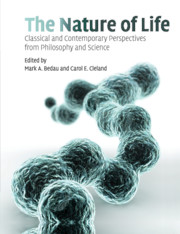Book contents
- Frontmatter
- Contents
- Preface
- Acknowledgments
- Sources
- About the authors
- Introduction
- SECTION I CLASSICAL DISCUSSIONS OF LIFE
- SECTION II THE ORIGIN AND EXTENT OF NATURAL LIFE
- SECTION III ARTIFICIAL LIFE AND SYNTHETIC BIOLOGY
- SECTION IV DEFINING AND EXPLAINING LIFE
- 23 Definitions of life
- 24 The seven pillars of life
- 25 A universal definition of life: autonomy and open-ended evolution
- 26 Does ‘life’ have a definition?
- 27 Sentient symphony
- 28 What is life?
- 29 Universal Darwinism
- 30 What is life? Was Schrödinger right?
- 31 Four puzzles about life
- Supplementary bibliography on life
- Index
- References
26 - Does ‘life’ have a definition?
Published online by Cambridge University Press: 10 November 2010
- Frontmatter
- Contents
- Preface
- Acknowledgments
- Sources
- About the authors
- Introduction
- SECTION I CLASSICAL DISCUSSIONS OF LIFE
- SECTION II THE ORIGIN AND EXTENT OF NATURAL LIFE
- SECTION III ARTIFICIAL LIFE AND SYNTHETIC BIOLOGY
- SECTION IV DEFINING AND EXPLAINING LIFE
- 23 Definitions of life
- 24 The seven pillars of life
- 25 A universal definition of life: autonomy and open-ended evolution
- 26 Does ‘life’ have a definition?
- 27 Sentient symphony
- 28 What is life?
- 29 Universal Darwinism
- 30 What is life? Was Schrödinger right?
- 31 Four puzzles about life
- Supplementary bibliography on life
- Index
- References
Summary
INTRODUCTION
The question “What is life?” is foundational to biology and especially important to astrobiologists who may one day encounter utterly alien life. But how should one approach this question? One widely adopted strategy among scientists is to try to define ‘life’. This chapter critically evaluates this strategy. Drawing from insights gained by philosophical investigations into the nature of logic and language, we argue that it is unlikely to succeed. We propose a different strategy, which may prove more fruitful in searches for extraterrestrial life.
We begin by reviewing the history of attempts to define ‘life’, and their utility in searches for extraterrestrial life. As will become apparent, these definitions typically face serious counterexamples, and may generate as many problems as they solve.
To explain why attempts to define ‘life’ are fraught with so many difficulties, we must first develop the necessary philosophical background. Therefore, on pp. 328–331 we discuss the general nature of definition and of so-called theoretical identity statements. Pages 332–334 then apply the material developed in these sections to the project of defining ‘life’. We argue that the idea that one can answer the question “What is life?” by defining ‘life’ is mistaken, resting upon confusions about the nature of definition and its capacity to answer fundamental questions about natural categories (Cleland & Chyba 2002).
To answer the question “What is life?” we require not a definition but a general theory of the nature of living systems.
- Type
- Chapter
- Information
- The Nature of LifeClassical and Contemporary Perspectives from Philosophy and Science, pp. 326 - 339Publisher: Cambridge University PressPrint publication year: 2010
References
- 6
- Cited by



